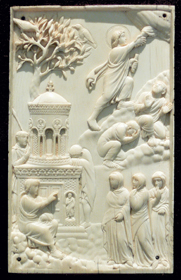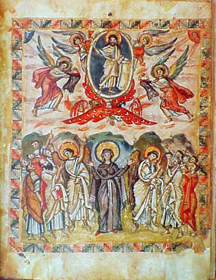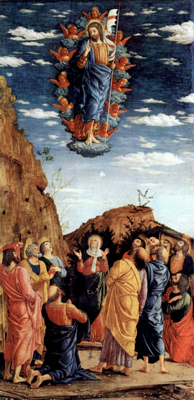From Our Archive
Debie Thomas, "A Lover's Prayer" (2021) and "I Am Asking" (2018); Dan Clendenin, "Judas and Matthias: Human Decisions and Divine Destiny" (2012).
For Sunday May 12, 2024
Lectionary Readings (Revised Common Lectionary, Year B)
1 John 5:9-13
John 17:6-19
Psalm 1
This Week's Essay
THANK YOU to Michael Fitzpatrick for a six-week series of lectionary essays from Easter to Pentecost. Michael was a regular staff writer for JWJ from 2020 to 2023. He is a U. S. Army veteran and philosopher. He served five years in the Army as a Chaplain's Assistant, which included two deployments to Iraq during 2004-05 and 2006-08. Michael is finishing his PhD at Stanford University.
As we near the culmination of Eastertide, we approach that moment in which the resurrected Christ is no longer immediately present to his friends and the Holy Spirit arrives in the community of Christ followers. It can be easy to miss this opportunity to wrestle with an obvious question: if Christ is risen, then why can’t we see him now? Why did Jesus appear in glory and then go away? Wouldn’t it be much better for us if Jesus was still here, in our midst, showing his resurrection body to the world that all might believe?
The ascension of Christ is probably one of the least taught and more poorly understood of the Church’s doctrines. We affirm it in our creeds, but for many of us it can feel like an awkward transition into Pentecost, almost as if the early church just had to say something to explain Christ’s absence — and this is what they came up with.
 |
|
Ivory plaque, c. 400, Italy. The earliest ascension image?
|
Our Gospel reading returns us to John’s description of Jesus’ discourse on the night he was betrayed, where we encounter Jesus praying to his Father to protect his followers because “I will remain in the world no longer, but they are still in the world, and I am coming to you” (17.11). Jesus going to his Father after his resurrection was not an accident but integral to his mission. Two assertions inform Jesus’ anticipation of his ascension. The first is that Jesus is not of the world, but is sent by God into the world to achieve our salvation. So he’s returning from whence he came. The second assertion is that Jesus’ followers “are not of the world, even as I am not of it” (v. 16). Note the prepositions. Truly following Jesus does not remove us from being in the world, but it does mean we are no longer of the world. So Jesus is returning to the One who sent him, while we remain in the world.
If Jesus is going to the Father, why couldn’t his followers go with him and escape this world of woe? Jesus says, “My prayer is not that you take them out of the world but that you protect them from the evil one” (v. 15). Jesus wants his followers to remain in the world, under the Father’s protection, because he sends us to others just as he was sent to us (v. 18). The world is the mission and we are in it to preach the Good News of Jesus that all might be saved.
If we are to remain in this world to be sent to others, shouldn’t Jesus have stayed to continue his mission? Well, the missions are different! We’re not here to be the savior of the world; quite the opposite. We’re sent to live lives that point back to Jesus, just as Jesus lived to point all people to his heavenly Father. In his prayer Jesus says that “the hour has come” at which “I have brought you glory on earth by finishing the work you gave me to do” (v. 4). The ascension is how Jesus finishes his work now that the hour has come.
 |
|
Rabbula Gospel, c. 586, Syria.
|
When Christians today reflect on the work of Christ to bring salvation, we typically focus on the death and resurrection of Jesus. But for much of church history, Jesus’ exaltation to the right hand of the Father has been seen as equally indispensable to Christ’s life-giving victory over sin and death. Declaring that Jesus is Lord means Jesus has been given God’s own authority over all of creation. He sits in the place of the Father. This sovereignty over the world does not mean his absence from it. What changed at the ascension of Christ was his spatiotemporal limitedness. If Jesus had remained in a resurrected terrestrial state, he could only be Lord and Messiah for a handful of people, those who lived in his immediate proximity. The declaration that Jesus has ascended to heaven is not a claim so much about his body leaving earth as it is an assurance that Jesus is now present for everyone. While the appearances gave the disciples confidence that Jesus was risen in the flesh, the ascension allows Jesus to be the center of all things, not just the center of Galilee.
Dwelling on these aspects of Christ’s ascension led St. Thomas Aquinas to say that the ascension is the cause of our salvation; it is essential to how Christ saves us. When we talk about the atonement of Christ, we should talk about the ascension. According to Aquinas, the passion and death of Christ served to remove our sin, accomplishing atonement by taking away the barrier to life with God. However, Christ’s ascension “is the direct cause of our ascension, as by beginning it in Him who is our Head, with whom the members must be united” (Summa Theologiae III.57.6). In other words, whatever Christ does he will do in us if we are united to him. By uniting with him, we participate in his death, his resurrection, and his ascension into the glory of God’s goodness.
The collect appointed for this Sunday in the Book of Common Prayer (1979) puts it this way,
O God, the King of glory, you have exalted your only Son Jesus Christ with great triumph to your kingdom in heaven: Do not leave us comfortless, but send us your Holy Spirit to strengthen us, and exalt us to that place where our Savior Christ has gone before; who lives and reigns with you and the Holy Spirit, one God, in glory everlasting. Amen.
God exalts Christ so that we might be exalted with him. If exaltation is what God does from the side of eternity, ascension is that outward and visible sign of God’s action from the side of history. It’s God’s historical testimony to what has been done for us in Jesus.
Aquinas insists that these reflections are not speculative or abstract, but that the ascension of Jesus produces concrete transformation to our daily life. By ascending into heaven and thereby withdrawing his resurrected body from our immediate access, Christ invigorates our faith, hope, and love.
We have a deeper faith because we are trusting in a resurrected Christ we cannot prove (say, by touching his side), and so cannot master.
We have a stouter hope because Christ has promised that his deeds will be done in us, assuring us that if he has ascended into heaven, then the way is open for us to follow.
We have a purer love because our eyes are lifted heavenward; we’re no longer tempted to perceive Jesus as a mere creature, for we pray to the Jesus who holds within himself all the good things of God.
 |
|
Andrea Mantegna, 1431-1506.
|
Jesus’ work is wrapped up in the whole of his life, death, resurrection, and exaltation to the throne of God, that last of which ascension is the outward and visible sign. Together, these extraordinary themes form God’s testimony, the testimony our epistle reading proclaims God has given about his Son. “Whoever believes in the Son of God accepts this testimony,” the author writes, because if we do not accept Jesus then we make God out to be a liar. Jesus is God’s testimony (1 John 5.10). We believe that Christ ascended into heaven because this is God’s testimony to us of what has been done out of love for us in Jesus.
The core of the testimony is that “God has given us eternal life, and this life is in his Son. Whoever has the Son has life; whoever does not have the Son of God does not have life” (vv. 11-12). When Jesus was raised from the dead, he was raised to eternal life, and whosoever is in him shares in that life. By ascending into heaven, Jesus has authority to give eternal life to whosoever is in him. Because he has ascended, so we can ascend with him. If we have the Son, we have life, true life. We have life in God.
Near the end of 1 John, the author writes, “And we are in him who is true by being in his Son Jesus Christ. He is the true God and eternal life” (v. 20b). Atonement is about being welcomed into complete unity with God. If we ascend with Christ, we are in the Son who has already ascended. If we are in the Son, then we are in the true God who is eternal life, because the Son is in God. We are taken into the God who loves us utterly and completely, who sent his Son to bring us into the fullness of that kingdom which is not of this world.
May we conclude our celebration of Easter with thanksgiving for God’s testimony in Jesus’ ascension, that by his exaltation we can have a deeper faith, a stouter hope, and a purer love, the virtues of life in the Son.
Weekly Prayer
Louise Glück
I have a friend who still believes in heaven.
Not a stupid person, yet with all she knows, she literally talks to God.
She thinks someone listens in heaven.
On earth she's unusually competent.
Brave too, able to face unpleasantness.We found a caterpillar dying in the dirt, greedy ants crawling over it.
I'm always moved by disaster, always eager to oppose vitality
But timid also, quick to shut my eyes.
Whereas my friend was able to watch, to let events play out
According to nature. For my sake she intervened
Brushing a few ants off the torn thing, and set it down
Across the road.My friend says I shut my eyes to God, that nothing else explains
My aversion to reality. She says I'm like the child who
Buries her head in the pillow
So as not to see, the child who tells herself
That light causes sadness—
My friend is like the mother. Patient, urging me
To wake up an adult like herself, a courageous person—In my dreams, my friend reproaches me. We're walking
On the same road, except it's winter now;
She's telling me that when you love the world you hear celestial music:
Look up, she says. When I look up, nothing.
Only clouds, snow, a white business in the trees
Like brides leaping to a great height—
Then I'm afraid for her; I see her
Caught in a net deliberately cast over the earth—In reality, we sit by the side of the road, watching the sun set;
From time to time, the silence pierced by a birdcall.
It's this moment we're trying to explain, the fact
That we're at ease with death, with solitude.
My friend draws a circle in the dirt; inside, the caterpillar doesn't move.
She's always trying to make something whole, something beautiful, an image
Capable of life apart from her.
We're very quiet. It's peaceful sitting here, not speaking, The composition
Fixed, the road turning suddenly dark, the air
Going cool, here and there the rocks shining and glittering—
It's this stillness we both love.
The love of form is a love of endings.Louise Glück (born April 22, 1943) is an American poet. She won the National Book Award for Poetry in 2014 for Faithful and Virtuous Night, the Pulitzer Prize in 1993, and the Nobel Prize in 2020.
Michael Fitzpatrick cherishes comments and questions via m.c.fitzpatrick@outlook.com
Image credits: (1) Wikipedia.org; (2) Wikipedia.org; and (3) Vanderbilt.edu.





